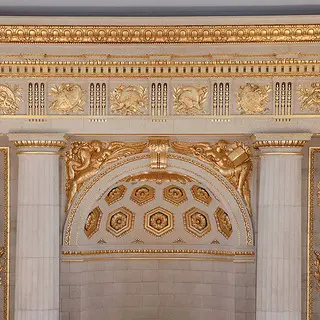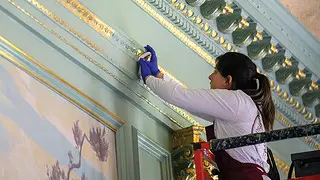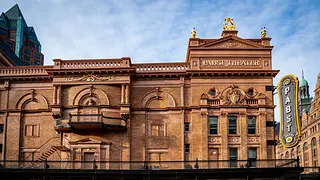
5 Historic Places That Highlight the Time-Honored Practice of Gilding
Since the heyday of ancient civilizations in places such as Egypt, Greece, and China, gold has fascinated people like no other metal. Its gleam has brightened building elements, works of art, and decorative objects over the centuries, nearly always conveying value and exceptionalism. “Gold is pretty,” says Mark J. Rabinowitz, a longtime conservator who has overseen major regildings like that of the U.S.S. Maine National Monument in New York’s Central Park. “It’s almost incorruptible, immutable. It’s a symbol of pureness, brightness, wealth. That’s why we hoard it still.”
Because of its high cost, builders and architects tend to use gold sparingly, often reserving it for locations where its telltale shine can capture as wide an audience as possible. That was the case with Independent Man, the gilded bronze statue atop the Rhode Island State House in Providence. Sculpted by George Brewster and placed on the marble dome of the McKim, Mead & White–designed building in 1899, the work underwent a 2024 restoration led by Rabinowitz as a consultant with EverGreene Architectural Arts. The 14.5-foot-tall Independent Man had last been treated in 1976, and when the state temporarily removed it to make repairs to the dome, the governor’s office decided to restore its deteriorating finish.

photo by: Wolf Matthewson
A detail of the regilded Independent Man statue before its return to the top of the Rhode Island State House.
The 1976 project had used gold plating—a jewelry-making tradition in which a gold solution is applied with an electrical current—rather than gilding, which uses thin sheets of gold or other metal leaf. Rabinowitz and his EverGreene colleagues first restored the gold-plate layer to create a surface that gold leaf would adhere to. Working in a state-owned armory inside a custom enclosure made to keep dust out, the team regilded the statue using 23.75-karat sheets of gold leaf applied to a drying oil called a size. “The gold is bonded and clings to that surface as [the size] dries,” Rabinowitz says. The regilded Man remained on display for a few months before cranes lifted it back onto the dome, exactly 125 years after it was first installed.
Most architectural gilding follows this tradition of oil gilding, which uses an oil-based size. (Water gilding, more commonly used on furniture and picture frames, entails a different type of surface prep and size.) Once applied, the oil size takes time to reach its optimal dryness, so gilders operate on a high-pressure schedule. “There’s a moment of time, a window, where the [size] has this kind of tacky feel to it, but it’s not wet. So you can touch it, but it doesn’t transfer,” says David Riccio, president and principal conservator at John Canning & Co. This window when the size is “open,” as gilders call it, typically lasts up to 12 hours, depending on humidity and other factors, and that’s the time to apply the precious gold leaf.

photo by: Carol Highsmith Photography/GSA
The restored doors at Mellon Auditorium.
One of Riccio’s recent conservation projects took place inside Washington, D.C.’s Andrew W. Mellon Auditorium (shown at top), a Beaux-Arts event space owned by the United States General Services Administration. Designed by San Francisco architect Arthur Brown Jr., the ornate auditorium has served as the setting for key historical events such as the signing of the treaty that established NATO. Mellon contains spectacular gilded detailing on its columns, walls, and the entablature around the 60-foot-high ceiling. According to Brown’s 1930s specifications, this gilding consists of Dutch metal, a composition metal that mimics the appearance of gold leaf. The less-expensive composition leaf can be used for interior locations with minimal exposure to the oils on human hands. For the regilding, the Canning team applied the Dutch metal leaf on an oil size—the same way as with gold leaf—and took the added step of varnishing it afterward to prevent the copper-and-zinc leaf from oxidizing. Now the ornamental moldings and bas-reliefs of cornucopia, eagles, and other symbols of abundance and power glow as they did when President Franklin D. Roosevelt dedicated the auditorium in 1935.
Artisans from another company, The Craftsmen Group, regilded the panel molding and other detailing on Mellon’s roughly 12-foot-tall doors, using 24-karat gold leaf. They burnished their work using the animal-hair brushes that gilders have used for decades. “[With genuine gold leaf,] once it’s burnished, it is done,” Canning’s David Riccio says. “Gold is very durable and stable.”

photo by: Jeff Bartee
The ballroom at Filoli, after its restoration.
Stay connected with us via email. Sign up today.
Across the country in Woodside, California, another sparkling post–World War I interior received a restoration in 2024. At Filoli, a National Trust Historic Site, original owner Agnes Bourn oversaw the design of the house’s ballroom herself, working with artists Ernest Peixotto and Bruce Porter. She modeled the 1926 space after rooms at Versailles, setting off its sea-green walls and oversize landscape paintings with judiciously applied 24-karat gold leaf.
Rowan Geiger and her team at Preservation Arts took on some aspects of the room’s restoration, including the gilding, fireplace detailing, landscape paintings, and faux-marble baseboards. While the gilding around the ceiling was in good condition and only needed cleaning and spot repairs, the gilded elements below it, such as the chair rail and the trim around the paintings, had suffered over the past century. “The gold had sort of matte-ed out from people touching it all over that time,” says Geiger, the company’s president and principal conservator. The regilding of those pieces was carefully sequenced with other work happening in the room, so that any remaining dust could be cleared out—if dust gets into the size, it can potentially ruin the finish.

photo by: Jeff Bartee
Conservator Kelsey Fox at work at Filoli.
The team used traditional squirrel-hair brushes to apply the oil size. “[The squirrel hair has] the perfect combination of softness and elasticity and strength,” says Kelsey Fox, associate paintings conservator at Preservation Arts. Since the ballroom’s restoration, Filoli has taken advantage of the space’s renewed glamour to host concerts there, just as the Bourns did. “The gilding was the final touch,” says Willa Brock, director of collections and interpretation at the site. “It’s the glittering necklace that you’re putting on this already beautiful room.”
The same could be said for the Pabst Theater, a landmark Milwaukee venue with prominent gilding inside and out. Conrad Schmitt Studios has helped maintain the building’s gold accents for almost a century. Its most recent project there was a regilding of key exterior pieces like the iron “Pabst Theater” lettering, the lyre and urns that top the structure, and other architectural details.

photo by: Conrad Schmitt Studios
Regilded exterior details at Milwaukee's Pabst Theater.
Eileen Grogan, director of historic preservation at Conrad Schmitt, says that while exterior gilding can last 20 or 30 years, the impact of harsh winters and bird droppings eventually takes a toll. Her team removed the existing finish and cleaned and prepped the pieces for regilding—keeping most of them in place and taking down a few items to work on at the company’s studio. With the 23.75-karat gold-leaf application complete, the theater once again glitters both up close and from a distance, beckoning potential patrons.
Domes are some of the most popular architectural features to gild, as they tend to be easily visible from far away. Architecture and planning firm Beyer Blinder Belle collaborated with EverGreene Architectural Arts and general contractor Nicholson & Galloway in 2024 to regild the 16-sided dome at St. Vartan Armenian Cathedral in New York City. The project entailed building an elaborate scaffolding and temporary stair systems around the dome to give the EverGreene team a safe, wind-protected place to work. (One errant gust can send delicate gold-leaf sheets flying.)

photo by: Chris Zakian
St. Vartan Armenian Cathedral after its 2024 regilding.
Dating to 1968, the cathedral is a midcentury interpretation of the 7th-century cathedral of St. Hripsime in Vagharshapat, Armenia. The original cross atop St. Vartan had been lost, so senior preservation architect Graham Roscoe of Beyer Blinder Belle designed a new one partly inspired by the first version. Crews used a crane to hoist the new cross about 120 feet up to the top of the dome so it could be gilded in place. A new lighting scheme by the Renfro Design Group highlights the dome at night, and EverGreene also restored the gilding on the bas-reliefs that grace the building’s facade.
The St. Vartan regilding work is part of a multiphase restoration, led by Beyer Blinder Belle Partner and Director of Historic Preservation Richard Southwick, that is slated for completion in 2028. Now that the regilding portion is done, those taking the FDR Drive along the East Side of Manhattan can spot the dome’s luster among a sea of gray and sand-colored buildings. “I think [the gilding] is very symbolic,” Southwick says. “It’s a really singular way of making this [building] important.”
Donate Today to Help Save the Places Where Our History Happened.
Donate to the National Trust for Historic Preservation today and you'll help preserve places that tell our stories, reflect our culture, and shape our shared American experience.



